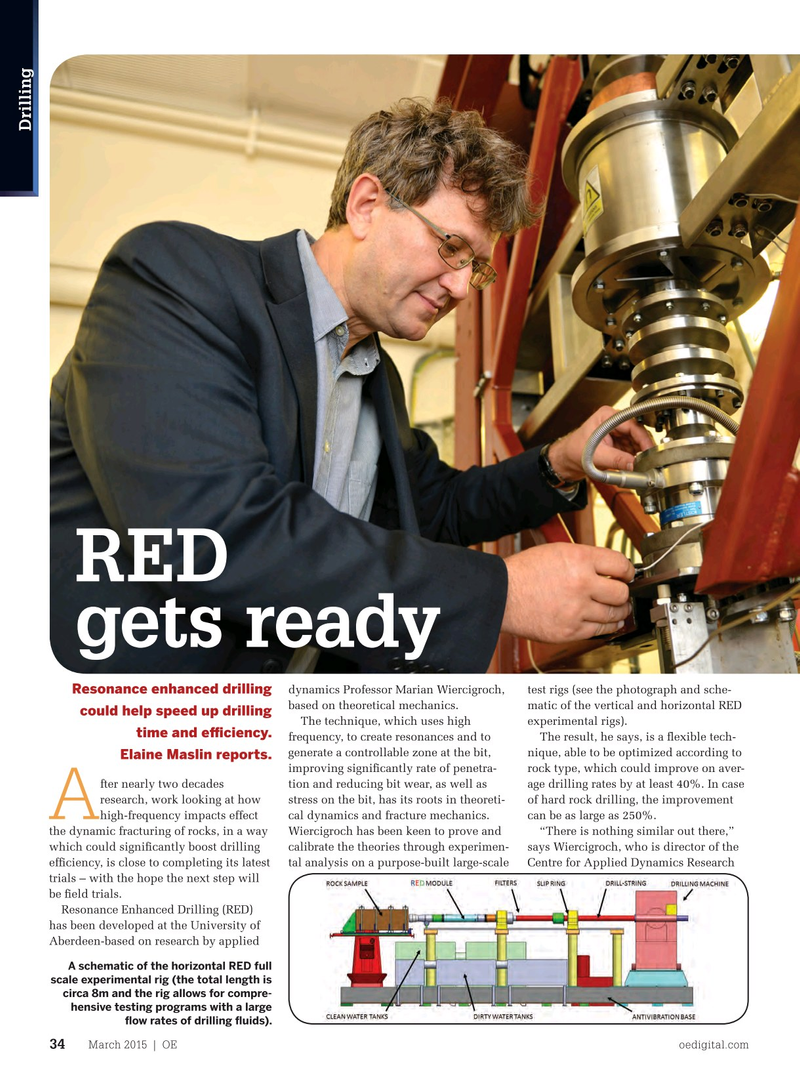
Page 32: of Offshore Engineer Magazine (Mar/Apr 2015)
Read this page in Pdf, Flash or Html5 edition of Mar/Apr 2015 Offshore Engineer Magazine
Drilling
RED
Professor Marian Wiercigroch with the gets ready vertical RED full scale experimental rig.
Images from the University of Aberdeen.
dynamics Professor Marian Wiercigroch, test rigs (see the photograph and sche- within the University of Aberdeen’s
Resonance enhanced drilling based on theoretical mechanics. matic of the vertical and horizontal RED School of Engineering. “It is excellent for could help speed up drilling
The technique, which uses high experimental rigs). hard rocks and could reduce the cost of time and efciency. frequency, to create resonances and to The result, he says, is a fexible tech- drilling signifcantly which is so impor- generate a controllable zone at the bit, nique, able to be optimized according to tant in the current situation.”
Elaine Maslin reports.
improving signifcantly rate of penetra- rock type, which could improve on aver- Classic drilling technology uses axial fter nearly two decades tion and reducing bit wear, as well as age drilling rates by at least 40%. In case static force (weight on bit) and rota- research, work looking at how stress on the bit, has its roots in theoreti- of hard rock drilling, the improvement tion, to shear off layers of the formation
A high-frequency impacts effect cal dynamics and fracture mechanics. can be as large as 250%. being drilled. RED adds high frequency the dynamic fracturing of rocks, in a way Wiercigroch has been keen to prove and “There is nothing similar out there,” oscillatory loading to the rotary drill which could signifcantly boost drilling calibrate the theories through experimen- says Wiercigroch, who is director of the bit. In other words, with RED control- effciency, is close to completing its latest tal analysis on a purpose-built large-scale Centre for Applied Dynamics Research lable high-frequency axial vibration is trials – with the hope the next step will added, creating resonance conditions be feld trials. which dynamically fracture the rock. The
Resonance Enhanced Drilling (RED) frequency, typically around 150-800Hz has been developed at the University of depending on the application, with 1mm
Aberdeen-based on research by applied maximum amplitude, is created using a transducer, and can be adjusted accord-
A schematic of the horizontal RED full ing to the drilled formation. scale experimental rig (the total length is
To protect instrumentation behind circa 8m and the rig allows for compre- the drill bit, transducer and exciter hensive testing programs with a large unit, a vibration isolation unit has been fow rates of drilling fuids).
March 2015 | OE oedigital.com 34 034_OE0315_D&C_RED.indd 34 2/22/15 11:23 AM

 31
31

 33
33